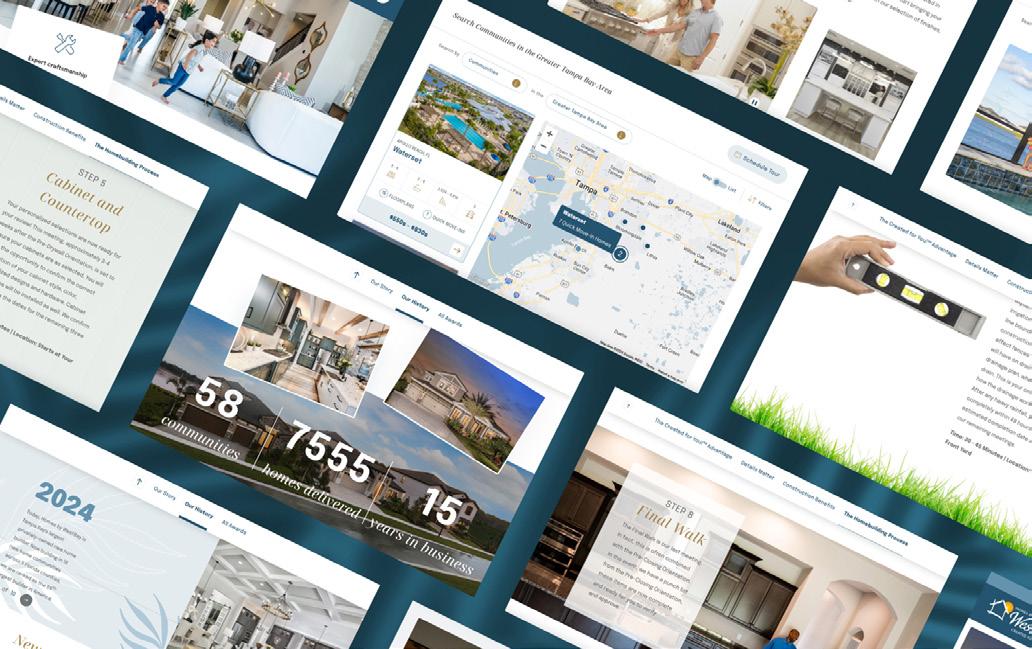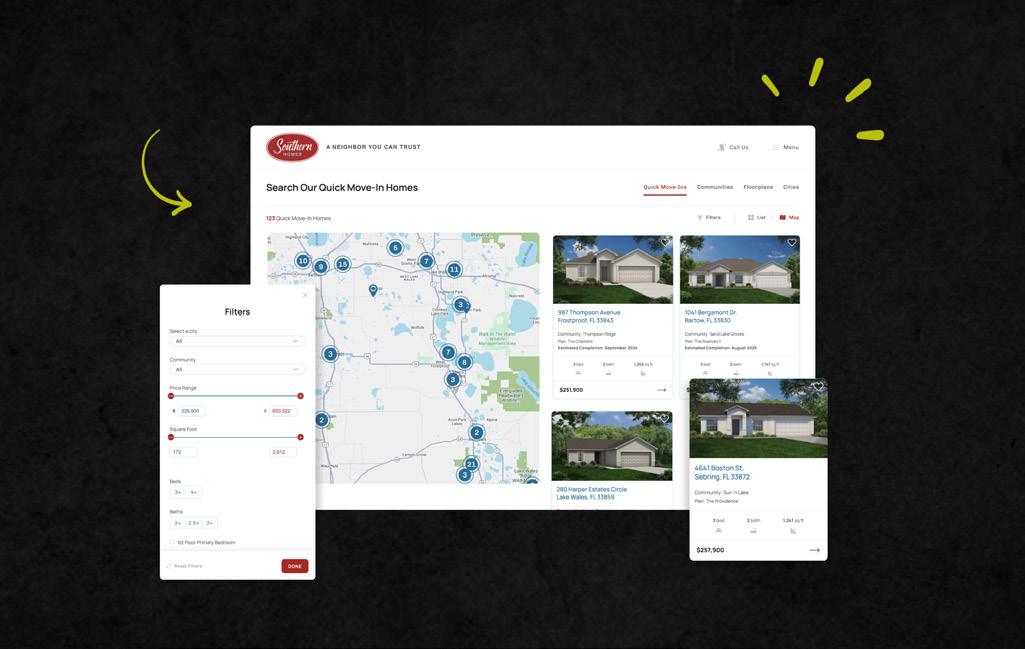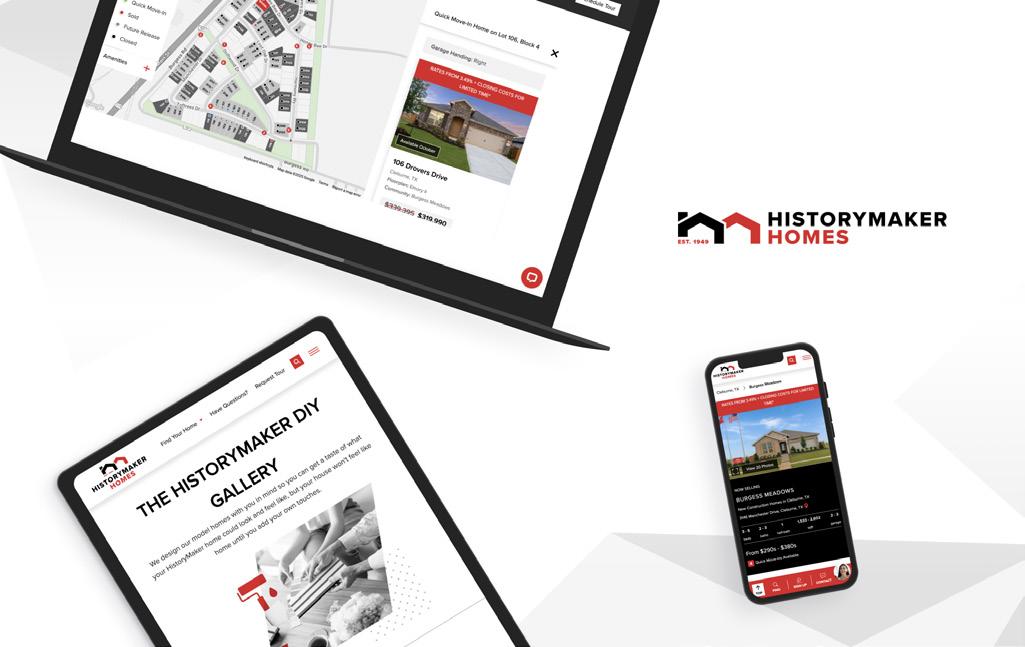

Home Builder Digital Trends Report

IntroductionGraphic Language is a dynamic web design and digital marketing agency that has carved a niche in the homebuilding industry. With a mission deeply rooted in innovation, we take pride in creating digital solutions that drive results. Our team of creative professionals is dedicated to designing engaging websites, executing strategic marketing campaigns, and providing a suite of services that enhance online visibility and sales for home builders.
We’re drawing on our experience in the homebuilding industry to share invaluable insights to help home builder marketers bolster their digital initiatives. Our goal is leverage our expertise and findings to help guide your digital strategy so you can turn prospects into buyers.
Contributors: Chris Ochs, Brea Buffaloe, Teana Halford
Copyright © 2025 by Graphic Language, Inc. All rights reserved. No part of this publication may be reproduced, distributed, or transmitted in any form or by any means without the prior written permission of Graphic Language, Inc.


Digital Marketing Strategy
7 Tips for Creating Your 2026 Digital Marketing Budget
It’s that time of year again: budget planning season. With buyer behavior shifting, digital platforms evolving, and AI playing a bigger role, creating a smart marketing budget is more critical than ever.
To help you plan, we’ve pulled together some key insights from our nearly 30 years of helping home builders grow online. These tips will help you allocate your budget strategically and ensure every marketing dollar works for you in 2026.
Understanding the importance of adapting to the digital world, we have compiled seven essential tips that will guide you in creating an effective and strategic digital marketing budget for 2026. These insights will help you allocate resources wisely, optimize your marketing efforts, and ensure a successful approach to connecting with your audience in the coming year.
First things first: ASK (AND ANSWER) SOME INTRODUCTORY QUESTIONS
Answering some basic foundational questions before allocating dollars to specific line items is key. Some of the most important questions to have answers to are:
What are your goals for 2026?
Start with your sales goals (by region/division if applicable) and work back to appointments, leads, and website visits. If you have defined conversion rates for your business, great, use those. If you don’t, we have found the

following to be a good rule of thumb for goal-setting purposes based on Q3 2025 home builder online performance for online generated sales:
• Web Visit > Lead = 1.5%
• Lead > Appointment = 40%
• Appointment > Sale = 18%
So, as an example, if your sales goal is 50 homes, then working backward, you would need 278 appointments, 695 leads, and 46,333 website visits.
Quick Note: We tend to be conservative in our percentages in order to put more emphasis on top-of-funnel web traffic numbers. That way, if you convert at a higher rate, then you exceed your goals, and everyone wins. Also, you aren’t relying on “best in class” conversion figures just to meet your baseline goals.
Did you meet your goals from last year?
If so, you might want to make some minor adjustments to incorporate new tactics and strategy and run it back. If not, you’ll want to try some new tactics.
What is your total budget?
A good baseline for your total marketing budget continues to be 1% – 1.5% of the total projected revenue for the year.
Has anything changed within your markets?
What does your land position look like? Have absorption rates changed? Are there any new competitors joining or old competitors leaving the market?
Are you happy with your current website?
Your website should be treated like your most valuable storefront. It will get hundreds of times more traffic than any of your models, so make sure it is the best and most accurate representation of your brand. If, after an honest assessment, you need a major refresh or redo then you’ll need to make the necessary adjustments to your advertising spend (unless you can pull from capital reserves).
Where should those digital dollars go?
Once you have answered the above questions, you can focus on allocating your marketing budget. Here are 7 highlevel tips for building a successful 2026 marketing budget to help you sell more homes.v

Prioritize Digital
Digital is undeniable: 97% of home buyers look online as their first step and use online tools during the home search process. That’s why your budget should prioritize your digital efforts. We recommend allocating at least 65% of your marketing budget toward your online presence.
Investing in digital advertising can increase your visibility on various platforms where potential buyers are searching, from social media to property listing websites. Content creation should focus on educational and engaging materials that resonate with your target audience, positioning your brand as a trusted industry authority.
Treat Your Website Like Your Most Important Storefront
Your website’s role cannot be understated; it should serve as the ultimate sales tool in your arsenal. Just as potential buyers scrutinize every detail in a model home, they’ll also examine your online presence with equal attentiveness. Regularly investing in your website is comparable to seasonally redecorating a model home, ensuring it remains appealing and up-to-date.
Allocate funds for enhancements that align with the latest digital trends and user preferences, such as improving navigation, enabling faster load times, and ensuring it is mobile-friendly. Consider incorporating customer testimonials, virtual tours, and interactive content to engage visitors and maintain their interest. By continually improving your web presence, you can attract more visitors and convert them into prospective leads, contributing significantly to your marketing success in 2026 and beyond.
Don’t Forget Content
Even the best outreach strategy is worthless without proper website content. High-quality content is the backbone of your digital presence, setting you apart from competitors and reinforcing your brand identity. Dynamic photography and videography bring your brand to life, enhancing online viewing experiences. Highlight lifestyle and product shots that evoke emotion and connection, encouraging potential customers to envision your offerings in their own lives. As digital engagement continues to rise, video content becomes a key driver (91% of consumers want to see more online videos from brands), with platforms favoring it in algorithms. Complement visual content with powerful storytelling through SEO-optimized copywriting, boosting your site’s ranking and providing informative and engaging narratives.
Don’t overlook the significance of integrating user-generated content, such as reviews and testimonials, which can substantiate your brand’s credibility. Virtual tours and interactive elements like quizzes or tools can keep visitors

engaged longer, increasing the likelihood of conversion.
Emphasize SEO and AEO
Organic search should be your biggest traffic source and leads (at least 40% of total traffic). However, don’t mistake organic search visits as “free” traffic; instead, they should be considered “earned” traffic. SEO is powerful for industries, like new home construction, where the buying cycle tends to be longer and more complex. This extended buying cycle offers additional opportunities to get your brand in front of prospects.
While the monetary investment isn’t as much as your paid advertising sources, the time investment is usually much larger. SEO optimization requires a complex strategy of developing on-page and off-page ranking factors to ensure your website and content are ranked on search engines.
Furthermore, with the rise of voice search, smart devices, and AI-powered assistants, Answer Engine Optimization (AEO) is becoming equally critical. AEO focuses on providing direct, concise answers to users’ questions, ensuring your content is selected as a “featured snippet” or a voice search answer. This often means structuring your content with clear question-and-answer formats and focusing on user intent rather than just keywords.
Unless you have an SEO/AEO pro on staff, it is definitely worth setting aside some budget to hire an expert (like Graphic Language) to help you succeed.
SEO and AEO are not set-it-and-forget-it tactics; they demand consistent effort and ongoing optimization. This involves a meticulous keyword research process (including long-tail and conversational queries for AEO), competitive analysis, and technical audits to ensure your website’s architecture is robust and search-enginefriendly. Regularly updating your website with fresh, relevant content and maintaining a well-structured site map is crucial for improving crawlability and indexing by search engines. Additionally, local SEO practices, such as managing online reviews and optimizing for location-based searches, can significantly boost visibility in your specific market area.
Be Everywhere
It sounds more daunting than it actually is. The majority of builder website traffic (about 90%) comes from 4 primary sources: organic search (SEO/AEO), paid search (like Google Ads), social media (primarily paid Facebook/ Instagram ads), and syndication sites (like Zillow and New Home Source).

Expanding your digital footprint across these channels ensures that your brand remains consistently visible where consumers spend their time online. By leveraging organic search effectively, you can capture users actively seeking information, making your website a key destination in their research journey. Paid search amplifies your reach, placing your offerings in front of potential buyers at the precise moment of intent, which can lead to higher conversion rates.
Maintaining an active presence on social media platforms allows your brand to engage with audiences in real time, fostering community and trust through authentic interactions and targeted campaigns. Lastly, listing on syndication sites such as Zillow and New Home Source not only broadens your market exposure but also legitimizes your presence in the competitive real estate landscape. By strategically balancing these efforts, you can create a comprehensive marketing approach that maximizes your outreach and attracts a diverse range of potential leads.
Try Something New
In today’s competitive housing market, simply advertising on Google Ads and Facebook may not be enough to stand out. There are several hidden opportunities off the beaten digital path, from niche social networks to cuttingedge geolocation tools. Exploring niche social networks like Houzz or Nextdoor can connect you directly with niche communities interested in home design and local events.
Additionally, leveraging platforms like Pinterest allows you to share visually appealing content that inspires and attracts prospective buyers. Integrating geolocation technology into your marketing strategy can provide hyper-targeted advertising, reaching potential buyers when they are physically near a property or model home. Experimenting with new formats like podcasts or live streaming can offer fresh avenues to engage with your audience and showcase your expertise in the industry. By diversifying your approach and harnessing these innovative channels, you can position your brand as a forward-thinking leader in the housing sector, capturing the attention of untapped audiences and creating lasting impressions.
Stay Flexible
No matter how hard we try, homebuilding is an unpredictable business. Communities sell out sooner than expected, or land comes on later than anticipated. The best-laid plans in January aren’t always right come summer.
That’s why we strongly recommend building some contingency dollars into your budget to ensure you can adjust and try new things as opportunities arise. Fostering a culture of flexibility within your team is essential. Encourage open communication and collaboration, allowing for swift decision-making and innovative problem-solving. You pave the way for sustainable growth and long-term success in the competitive homebuilding arena by anticipating
change and preparing for it.
Bonus Tip: Don’t ‘Set It and Forget It’
Your marketing budget is a living, breathing document that should be monitored and updated consistently throughout the year. Initiatives not working? Reallocate some dollars to a more successful tactic. Exceeding your sales goals? Pull back on your marketing spend a little bit (or keep it up and blow those goals out of the water if you have the land position). Land development delays in a certain area? Put a hold on your digital spending for a few months to save that money for pre-sale/launch activities.
Flexibility in your budget allows you to adapt to market dynamics quickly. Involving your team in the evaluation process can provide valuable insights and foster a collective sense of ownership and accountability. In the fastpaced world of homebuilding, remaining agile and adaptable ensures that your marketing efforts are efficient and aligned with your company’s evolving goals and the ever-changing market landscape.
Remember, the steps you take now in the budget planning process determine the success you will have in 2026! Don’t skimp on the front-end planning and reap the rewards in sales down the road. If you’re wondering how effective your current digital paid media strategy is, book a free digital strategy session or paid media audit with us. We’ll dive deep into your strategy and offer deep insights, actionable next steps, and an overall review to help you understand what’s working and where you can improve.

Website Design Trends
Redesign Now: A Builder’s Guide to a Slow Market
In a slow-selling market, many builders’ first instinct is to cut back on marketing to conserve resources and wait for buyer traffic to return. But what if this quiet period was actually your greatest strategic advantage?
While your competitors are hitting the brakes, a slowdown offers the perfect window to rebuild your most valuable marketing asset: your website. This is not an unnecessary expense; it’s a calculated investment in future sales.
You can get ahead of the curve, fine-tune your lead generation engine, and be perfectly positioned to capture market share when demand returns.
Here’s why smart builders act during the slowdown, and what you should focus on.
Why Redesign During a Slowdown? The Competitive Edge
In a hot market, everyone is too busy handling a flood of leads to consider a major project like a website overhaul. The risk of disrupting lead flow is too high. A slow market removes this obstacle, giving you the time and space to think thoughtfully and strategically.
While your competition’s digital presence remains static, you can be making significant leaps forward. Imagine the scenario when the market inevitably picks up: a potential buyer lands on your competitor’s dated, clunky website that’s difficult to use on a phone.

Then, they visit yours: it’s fast, modern, and provides an effortless, informative experience. The contrast immediately establishes your brand as more professional and trustworthy, giving you an immediate upper hand.
Adapt to Modern Home Buyer Behavior
Today’s homebuyer journey starts online, often months before they are ready to speak with a sales consultant. They are researchers, using their smartphones to compare builders, explore communities, and disqualify options based solely on their digital experience. A redesign allows you to meet these buyers where they are.
• Mobile-First is Non-Negotiable: The majority of your initial website traffic comes from mobile devices. Your site must be designed for thumbs, not mouse clicks. This means large touch targets, fast-loading pages, and easy navigation on a small screen. If a user has to pinch and zoom to view a floor plan, you’ve likely already lost them.
• Empower the Self-Serve Researcher: Buyers crave information and autonomy. Your website should be a comprehensive resource that allows them to explore without pressure. A redesign can incorporate powerful tools like interactive lot maps showing homesite availability, side-by-side floor plan comparators, and robust filters for spec homes to sort by move-in date, features, or price.
Build a Conversion-Focused User Experience (UX)
A beautiful website that doesn’t convert visitors into leads is just a digital brochure. The primary goal of a redesign should be to improve the user experience (UX) to guide visitors toward taking action.
Focus on these key areas for immediate wins:
• Prioritize Speed: A slow website is a lead killer. Every extra second of load time dramatically increases the chance a visitor will leave. A modern build focuses on optimized images, streamlined code, and efficient hosting to ensure a lightning-fast experience.
• Simplify Navigation: Can a visitor find your quick move-in inventory or community information in two clicks or less? A redesigned site structure should be intuitive, organizing content logically around the buyer’s needs, not your company’s internal structure.
• Craft Compelling Calls-to-Action (CTAs): Use clear, direct, and action-oriented language like “Schedule a Tour,” “View Quick Move-Ins,” or “Chat with an Expert.” Place these CTAs strategically on every relevant page.
• Streamline Forms: Long, complicated forms are a major point of friction. Shorten your contact forms to only the essentials: name, email, and phone. You can even integrate online appointment scheduling directly

on your site to remove another step for the buyer.
Mitigate Risk with Digital Compliance
An outdated website can be a source of hidden legal and regulatory risks. Use the redesign process to conduct a thorough audit and ensure your digital presence is fully compliant.
• Data Privacy: Regulations have strict rules about how you collect, store, and manage user data. Your redesign should include an updated, clearly written privacy policy and a compliant cookie consent mechanism to build trust and avoid fines.
• ADA Accessibility (WCAG): Your website needs to be accessible to all users, including those with disabilities. Adhering to Web Content Accessibility Guidelines (WCAG) involves proper color contrast, alt text for all images, and keyboard-navigable menus. This not only expands your potential audience but also protects you from costly lawsuits.
Execute a Full Content and SEO Reset
A redesign is the perfect catalyst for a complete content and search engine optimization overhaul. It’s your chance to build a strong foundation for local search dominance and ensure your information is fresh and relevant.
Start by focusing on your most valuable pages:
• Dynamic Community Pages: Transform these from static pages into rich content hubs. Include detailed amenity lists, school district information, lifestyle videos, interactive maps, and real-time inventory of available homes.
• Engaging Floor Plan Pages: Go beyond a simple PDF download. Create dedicated pages for each plan with multiple elevations, photo galleries, 3D tours, and clear specifications.
• Real-Time QMI Inventory: Ensure your quick move-in (QMI) listings are always up-to-date and easily searchable. This is often the highest-converting section of a builder’s website.
• Strengthen Local Search: Optimize your content for “near me” searches and phrases like “new homes in [City],” ensuring you capture high-intent local buyers.
Integrate Your Tech Stack for Smarter Nurturing
Your website should be the heart of your marketing technology. A redesign allows you to build powerful, seamless integrations that automate tasks and personalize the customer journey. By connecting your website to your CRM

and Marketing Automation (MA) platform, you can enable behavior-based nurturing.
For example, when a prospect saves a favorite floor plan, that data flows directly into your CRM. This can trigger a personalized email campaign from your MA system, sending them relevant information without any manual work from your sales team. This creates a highly effective and efficient follow-up process.
Capitalize on Budget and Time Efficiencies
Commissioning a website redesign during a downturn is also a smart financial move. Your internal team has more bandwidth to dedicate to the project, and web development agencies often have more capacity. This can translate to more competitive pricing, greater flexibility, and more dedicated attention for your project. You can achieve a better result for a lower cost than you would during a frantic, high-demand market.
Compact Website Audit Checklist
Not sure where your website stands? Run through this quick checklist:
• Mobile Test: Open your website on your phone. Is it easy to navigate without pinching or zooming?
• Speed Test: Use a free tool like Google’s PageSpeed Insights. Does your site load in under 3 seconds?
• 5-Second Test: Can a new visitor understand what you do and what action they should take within five seconds?
• Lead Capture: Is it obvious how to contact you or schedule a tour?
• Content Freshness: Is the copyright date in your footer current? Are your listed communities and homes up to date?
• If you answered “no” to any of these, it’s a clear sign that a redesign should be a priority.
Don’t Wait for the Market to Rebound
Don’t let this strategic opportunity pass you by. While others are waiting for the market to tell them what to do, you can be actively building the tool that will ensure you win the next cycle. Start the conversation about your website redesign today and prepare to dominate when the market turns.


AI Trends
AI & SEO: The Strategic Guide to Winning in the New Search Era
Artificial intelligence is not just another marketing trend; it’s a fundamental shift in how people find information online. This change is reshaping the very foundation of search engine optimization, moving us away from a simple list of links toward a world of direct, AI-generated answers. For marketing leaders and SEO practitioners, adapting isn’t optional; it’s essential for survival and growth.
The rise of “answer engines” and the “zero-click” reality means we must rethink our strategies. Here’s a comprehensive overview of what’s changing, practical workflows you can implement today, and a strategic roadmap to future-proof your marketing efforts. You will learn how to build visibility beyond the click and align your team for success in this new landscape.
The New Front Line: From Search Engine to Answer Engine
The most visible change is the transformation of search results pages. AI Overviews now synthesize information from multiple web pages to provide a single, comprehensive response directly to the user. This is incredibly convenient for users, but it means they often get what they need without clicking through to any website.
This “zero-click search” phenomenon is the new reality. The battle for visibility is no longer just about securing the top organic ranking; it’s about becoming a primary source for these AI-generated summaries. Your brand and expertise must be featured within the answer itself.

While the high-consideration nature of homebuying makes a true “zero-click” purchase unlikely—buyers still need to explore communities and floorplans—the imperative to adapt is just as strong. Homebuilders should still structure their content to be comprehensive and easily digestible for AI. By making key details readily available, they can secure a prominent place in AI-powered overviews and drive those all-important clicks, guiding prospects to their websites for the deeper engagement that leads to a sale.
How SEO Is Evolving for an AI-First World
The core principles of SEO still matter, but their application is changing. Success now hinges on demonstrating deep expertise and providing clear, structured information that AI models can easily parse and trust.
From Keywords to Entities and Topic Clusters
AI thinks in terms of entities, the people, places, things, and concepts related to a query; not just keywords. Instead of focusing on a single keyword, your strategy must broaden to cover a topic comprehensively. This is best achieved through topic clusters: a central “pillar” page covering a broad subject, linked to multiple “cluster” pages that explore specific sub-topics in detail. This structure signals your authority to search engines.
The Rise of Long-Tail and Conversational Queries
Voice search and AI chatbots have encouraged users to ask questions in natural language. Queries are becoming longer and more specific, like “what are the best noise-canceling headphones for open offices?” instead of just “noise-canceling headphones.” Your content must directly answer these highly specific, intent-driven questions.
The Undeniable Importance of E-E-A-T
In an environment filled with AI-generated content, trust is paramount. Google’s emphasis on Experience, Expertise, Authoritativeness, and Trustworthiness (E-E-A-T) is more critical than ever. Using AI to generate unoriginal, low-quality content is a losing game. The winning strategy is to use AI to enhance human expertise, ensuring every piece of content is fact-checked, features unique insights, and reflects your brand’s authentic voice.
A Practical, AI-Assisted SEO Workflow
Integrating AI into your daily tasks can dramatically improve efficiency and results. Here are practical, tool-agnostic workflows you can adopt now.
1. Supercharge Keyword and Topic Discovery
Use AI to move beyond basic keywords and map out entire topic territories.

• Workflow: Start with a broad topic (e.g., “customer relationship management”). Use an AI tool to identify related entities, concepts, and long-tail questions that potential customers are asking.
• Prompt Example: Act as an SEO strategist. My core topic is ‘customer relationship management.’ Identify the main related entities and concepts. Also, generate 20 long-tail, question-based keywords a small business owner might search for when evaluating CRM solutions.
2. Generate Data-Driven Content Briefs
Create comprehensive briefs that set your content creators up for success.
• Workflow: Choose a target keyword. Prompt an AI tool to analyze the top-ranking pages and generate an outline, key questions to answer, a list of related terms to include, and a suggested word count.
• Prompt Example: Create a content brief for a blog post targeting ‘how to reduce customer churn.’ Include a suggested H1, a meta description, a hierarchical outline with H2s and H3s, and 5 essential questions the article must answer based on top search results.
3. Accelerate First Drafts and On-Page Optimization
Overcome writer’s block and ensure your content is structured to perform.
• Workflow: Use your AI-generated brief to create a “shitty first draft” (SFD). This provides a solid foundation. Critically, a human expert must then rewrite this draft, infusing it with unique insights, brand voice, and realworld examples to ensure E-E-A-T. Then, use an AI tool to analyze the final draft for on-page optimization opportunities.
• Prompt Example: Analyze this article draft for on-page SEO. The target keyword is ‘B2B content marketing.’ Provide specific suggestions for improving the headings, incorporating related keywords naturally, and adding a section on ‘measuring content ROI’.
4. Streamline Technical SEO
Let AI handle some of the most time-consuming technical tasks.
• Workflow: For internal linking, ask an AI to scan your site and suggest relevant pages to link from to your new post. For schema, have an AI generate the correct JSON-LD markup (e.g., Article, FAQ, HowTo) to help search engines understand your content.
• Prompt Example: I published a new article about ‘email marketing automation.’ Suggest 5 existing pages on my site where I can add an internal link to this new post. Provide the source URL and recommended anchor text for each.

5. Prioritize Content Refreshes with Predictive Analytics
Use data to focus your content update efforts where they will have the most impact.
• Workflow: Connect your analytics data to an AI tool to identify pages with decaying traffic or keyword rankings. These are your top candidates for a content refresh. Predictive tools can also help forecast emerging topics in your industry.
• Prompt Example: Analyze my website’s Google Search Console data for the last 12 months. Identify the top 5 blog posts that have lost the most organic traffic and list their primary keyword.
Measuring Success Beyond the Click
Traditional metrics like click-through rate and organic traffic are no longer sufficient. You must evolve your measurement framework to capture the value of visibility within AI answers.
• Share of Voice in AI Answers: How often is your brand cited as a source in AI Overviews for your target topics?
• Branded Search Lift: Are your visibility efforts leading to more users searching directly for your brand name?
• Impression Growth: Track the total number of times your content appears in search, even if it doesn’t earn a click.

Your 9-Month Strategic Roadmap
Use this phased roadmap to guide your organization’s transition.
Quarter 1: Audit & Education (Months 1-3)
• Milestone: Audit your content library against AI-era formats (guides, FAQs, comparisons).
• Milestone: Educate leadership on the shift from clicks to visibility and the importance of E-E-A-T.
• Milestone: Pilot a new tool for tracking your brand’s mentions in AI Overviews.
Quarter 2: Experimentation & Reskilling (Months 4-6)
• Milestone: Launch your first “definitive guide” or “comparison hub” based on your audit findings.
• Milestone: Run a content refresh sprint, updating a key asset with comprehensive answers and FAQ schema.
• Milestone: Train your content and SEO teams on AI-assisted workflows and technical skills.
Quarter 3: Scale & Optimization (Months 7-9)
• Milestone: Develop a repeatable process for identifying and creating high-authority pillar content.
• Milestone: Integrate “visibility beyond the click” metrics into your official marketing dashboards.
• Milestone: Re-evaluate your budget to formally allocate resources for high-E-E-A-T content and AI-centric analytics.
Prepare for the Future of Search Today
The integration of AI into search is a defining moment for digital marketing. It rewards brands that provide genuine value and expertise. By focusing on topical authority, adopting AI-assisted workflows, and evolving how you measure success, you can build a defensible competitive advantage.
The time to act is now. Begin by auditing your current content strategy against the demands of this new AI-powered world. Then, pilot a single AI-assisted SEO sprint to see the results for yourself. The leaders who embrace this shift will define the future of their industries.

AI Trends
How Homebuilders Can Design an AI-Friendly Website
As a homebuilder, your website is your most powerful sales tool. It attracts potential buyers, showcases homes, and converts visitors into leads. But beyond human visitors, you also need to consider AI systems like search engine crawlers, voice assistants, and chatbots.
If these tools can’t easily understand your website, you could miss valuable traffic, local rankings, and opportunities to stand out in a competitive market. That’s why building an AI-friendly website is crucial.
This approach, sometimes called “AI-first indexing,” isn’t just about catering to robots. It’s about creating structured, clear, and trustworthy content that AI can easily process and buyers can enjoy. The steps that make your website AI-friendly will also improve the experience for your human visitors.
Why Homebuilders Need an AI-Friendly Website
AI now shapes how homebuyers discover builders, research communities, and explore new homes. Optimizing your website for AI offers clear benefits:
• Rank higher in local search: Search engines prioritize websites that are easy to crawl and contain structured, location-specific information.
• Win at voice search: More buyers are saying, “Hey Siri, show me new homes near Austin.” AI surfaces sites that provide the clearest, best-labeled answers.

• Showcase your properties more effectively: Galleries, virtual tours, and floor plans become easier to find when labeled with AI-friendly code.
• Future-proof your marketing: As AI becomes central to home search, an AI-friendly site ensures your brand remains visible and competitive.
Here are the strategies you can use to future-proof your homebuilder website.
1. Content Optimization
Optimizing your content is the first step to making your website AI-friendly and more valuable to potential homebuyers.
Focus on clarity and value
Buyers want straightforward answers to questions like:
• “What’s included in the base price?”
• “How long does it take to build a home?”
• “Can I customize my floor plan?”
Write naturally, avoid jargon, and provide concise, direct answers that AI can use in summaries. Support claims with verifiable data like industry stats, buyer surveys, or your own research. Cover multiple viewpoints, such as renting vs. buying, to improve credibility.
Structure for easy comprehension
Use a logical heading hierarchy across your pages:
• H1: Available New Homes in Dallas
• H2: Floor Plans, Gallery, Nearby Schools
• H3: Energy-Efficient Appliances, Open Concept Kitchens
Bullet points, comparison tables, and semantic cues like “Key takeaway” make your content scannable for buyers and easier for AI to extract. Always put the most important details, like pricing or location, up front.


Create machine-readable content
Don’t hide key details behind JavaScript. Property descriptions, incentives, or calls-to-action should appear in raw HTML.
Be sure to make your visuals AI-friendly:
• Add descriptive alt text to images of model homes, floor plans, and community maps.
• Provide transcripts for video walkthroughs or sales webinars.
• Add short text summaries or downloadable CSVs for infographics or market data.
2. Technical Optimization
Make sure your website works well for both users and AI by improving its structure, speed, and how easily data can be accessed.
Implement structured data
Structured data (Schema) adds code that tells AI what your content means. For homebuilders:
• Use LocalBusiness schema on your contact page to highlight your location, hours, and service area.

• Add Product or Offer schema to floor plan or inventory pages with details like price, availability, beds, and baths.
• Use Event schema for open houses or community launches.
• Validate your markup with Google’s Rich Results Test to ensure accuracy.
Enhance site structure and performance
Organize your site into clear categories: Communities, Quick Move-Ins, Floor Plans, and Blog. Link internally between related content to establish authority.
Other must-haves include:
• Descriptive, keyword-friendly URLs: “/communities/lake-wales/new-homes”
• XML sitemap and robots.txt/llms.txt setup for AI crawlers
• Fast-loading, mobile-first design (check Core Web Vitals)
• Clean semantic HTML5 tags like <header>, <nav>, <main>
Support AI integration
Enterprise builders can further enhance AI integration by providing APIs that offer real-time availability or pricing data for AI tools, and by offering downloadable CSV/JSON files containing detailed insights such as pricing for various design options or comprehensive market statistics.
3. Building Authority and Visibility
AI models favor content from established, trustworthy sources with deep expertise on a given subject.
Establish trust signals (E-E-A-T)
AI rewards authority and trust. Show it by:
• Adding bios for your sales team or construction managers with credentials
• Citing reputable sources in your blogs
• Earning backlinks from local media, real estate partners, or trade associations
Leverage engagement and social signals
Promote your blogs and community updates on LinkedIn, Instagram, and local homeowner forums. Share model home tours, announce open houses, and encourage interaction. Social signals show both buyers and AI that your brand is active and trusted.

Build topical authority
Create content clusters around buyer-focused topics that link to more focused, in-depth “cluster” pages. This signals to AI your comprehensive and authoritative coverage of a topic.
For example, a broad “pillar” page like The Homebuying Journey could link to more specific “cluster” posts such as Financing Your New Home, Design Studio Tips, and What to Expect on a Model Home Tour.
4. Enhancing User Experience
Beyond SEO, creating an excellent user experience is vital for both human visitors and AI.
Human-first design
AI optimization should never compromise human usability. Keep navigation intuitive with menus like Communities, Quick Move-Ins, Gallery. Ensure WCAG accessibility with transcripts, captions, and alt text.
A seamless experience makes buyers more likely to explore, and AI more likely to understand your site.
Balance AI tools with human creativity
AI can brainstorm blog ideas or draft copy, but your brand’s voice and personality make the difference. Always refine AI output to sound like you.
Monitor performance with analytics:
• Which blogs are cited in AI-powered summaries?
• Which community pages hold buyer attention?
Use that feedback to continuously improve.
Homebuilder Website AI-Readiness Checklist
• Structure pages with headings (H1, H2, H3) for communities, floor plans, and galleries
• Add schema markup for LocalBusiness, Product, and Event content
• Review media: alt text for property photos, captions for floor plans, transcripts for video tours
• Test mobile performance with your own phone and Google’s Mobile-Friendly Test
• Audit visibility: check your source code to ensure key info isn’t hidden behind JavaScript

An AI-friendly website is about more than technology; it’s about making your homes easier to find, trust, and love.
For homebuilder marketing professionals, the message is simple: optimize for both buyers and AI, and you’ll build a website that works 24/7 to attract, inform, and convert.

The Latest & Greatest
Inside Our Website Refresh
A Modern New Look for Graphic Language
We’re always pushing forward, not just in our work, but in how we present it. That’s why we’re thrilled to unveil our refreshed homepage. It brings our latest thinking, strongest visuals, and most up-to-date builder tools right to the forefront.
A Modern, Clean Look That Lets Our Ideas Shine
You’ll immediately notice a clean, confident, and engaging look. We’ve removed clutter, updated colors and fonts, and streamlined the layout to let our content shine. This strategic visual update ensures our brand reflects the speed and precision of modern home-builder marketing, clearly demonstrating what we do.
Bringing Our Work to Life with Short Reels
To truly showcase our work, we’ve added short, impactful video reels directly on the homepage. These quick visuals demonstrate dynamic builder tools, motion graphics, and live launch events, letting you experience our momentum and see our newest platforms and integrated tools in action.
Highlighting Our Latest Technologies
Our homepage now prominently features the innovative tech we use for builders, from digital toolkits and interactive buyer experiences to CMS design and immersive media, and our innovative SPOT MapsTM that allow builders to easily plot and deploy lot maps using their own graphics. Look for sections detailing ‘what’s new’ and ‘what’s now,’ proving we don’t just follow trends; we create them.

Showcasing Case Studies That Tell a Story
Our ‘Work’ section is improved with new case studies from our most recent website redesign projects, demonstrating the real impact for partners like HistoryMaker Homes, Homes by WestBay, and Southern Homes These stories blend strategy, execution, and clear results, inviting you to explore what’s possible.
A New Suite of Digital Services & Builder Tools
As home-building marketing evolves, so do our services. This update introduces a new suite of digital services and builder tools, including advanced lead-capture, improved analytics dashboards, and interactive buyer-journey workflows. Our homepage clearly outlines how these help builders solve problems and achieve results.
Why This Matters
Why does this matter? For our builder clients, evolving home-buyer engagement demands marketing partners who master both technology and storytelling, delivering tomorrow’s features and today’s performance. Our new homepage proves we think bigger, work smarter, and move faster. For visitors, it’s a clearer, more intuitive experience to grasp our capabilities and potential.
Try It for Yourself
We invite you to explore the updated homepage yourself. Watch a video, dive into a case study, or discover a service to transform your marketing. Our digital door is open, and this new look truly sets the tone for the next chapter in builder marketing.

On the Blog What We’re Talking About
Looking for more resources? We’ve curated a collection of our blog posts so homebuilders can boost their digital marketing strategies and more.

The Importance of a Website Audit for Homebuilders: A Comprehensive Guide
A website audit is an important tool to make sure your site is at its best. Explore the ins and outs of website audits and their benefits.

The Custom Advantage: Why Custom Websites Outshine Templates
A custom-designed website can be the key to standing out from the crowd. Here’s why you should consider a custom home builder website.
Read More
Read More


Balancing Your SEO and PPC Budgets
Struggling with your SEO and PPC budget? This guide helps homebuilder marketers effectively allocate funds between long-term growth and immediate paid ads.

How Long Does it Take for SEO to Show Results
Wondering how long SEO takes to show results? Learn how long, what affects your timeline, and how to speed up your site’s growth.
Read More

A Foundation Built Online: Southern Homes’ Digital Transformation
Explore the all-new Southern Homes website. Designed for easy home searches, virtual tours, saved favorites, and a more personal buying experience.
Read More

Inside HistoryMaker Homes’ Innovative New Website
Experience the new HistoryMakerHomes.com, featuring smart search, easy tour booking, SPOT™ Maps, special offers, and tools to simplify homebuying. Read More


Boost Your Digital Marketing Strategy in 2026
Need help with your digital marketing strategy? With over 27 years of experience working exclusively with home builders, we know what works. Connect with us to see how we can help fine-tune your digital marketing strategy.
Contact Us


